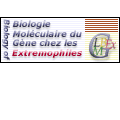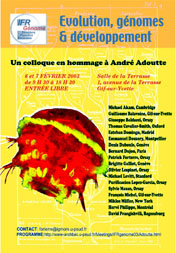|
|
|
||
|
|
Evolution, Génomes et Développement |
||
|
IFR GENOME:
Function , structure and evolution |
|||
IFR GENOME:
Function , structure and evolution

![]()
![]()









![]()
![]()






![]()

Evolution, Génomes et
Développement
Génome : Structure, Fonction, Evolution

Salle de la Terrasse à
Gif-sur-Yvette
http://www.igmors.u-psud.fr/IFR/
Michael Levitt
Simple but Complete Models of Protein Evolution
This talk, which is due to Yu Xia a student in my group, will show how mutation and recombination have dramatically different effects on protein stability. With dominant mutation, most protein sequences in an evolving population fold to a barely stable structure. With dominant recombination, most protein sequences in an evolving population fold to a very stable structure.
François Michel
The Evolution of Group II Introns
Self-splicing group II introns, which are believed to have given rise to the spliceosome and its substrates, have been found in mitochondria, chloroplasts, archaea and bacteria. I will focus on the processes by which these objects have evolved, taken surprising guises and adapted to unconventional genomic niches.
Giuseppe Baldacci
Permanence and impermanence of DNA replication mechanisms.
The most conserved aspects of enzymes and of protein complexes implicated in DNA replication will be discussed, from viruses to mammalian cells. The elusive nature of DNA replication origins will be discussed in an evolutionary and functional perspective.
Tom Cavalier-Smith
Membrane heredity in cell evolution
Esteban Domingo
Virus extinction by enhanced mutagenesis
David Prangishvili
Evolutionary insights from studies on viruses of hyperthermophilic archaea.
I will talk about diversity of these viruses, their unusual characteristics and possible relationships of some of them to large eukaryal dsDNA viruses.
Bernard Dujon
Molecular evolution of yeast genomes as revealed from comparative sequence analysis
I will summarize briefly the past and present status of yeast genomics: major lessons from S. cerevisiae and which species are now being sequenced (many and why). I will then focus on the "dynamics" of chromosomes with both compararive and experimental data. If time permits, I will finally review in more details our recent results of the complete sequence of the pathogenic yeast Candida glabrata.
Olivier Lespinet
The role of Lineage-Specific Expansions in the evolution of Eukaryotes.
A computational procedure was developed for the systematic detection of lineage-specific expansions (LSEs) of protein families in sequenced genomes and has been applied to obtain a census of LSEs in five eukaryotic species, the yeasts Saccharomyces cerevisiae and Schizosaccharomyces pombe, the nematode Caenorhabditis elegans, the fruit fly Drosophila melanogaster, and the green plant Arabidopsis thaliana.
Patrick Forterre
Evolution of archaeal genomes : insight from comparative genomics
General principles of prokaryotic genome evolution can be deduced from the comparative genomics of several closely related archaeal species and comparison with similar results obtained in Bacteria. I will focus on the comparative analysis of the genomes of three Pyrococcus species.
Purificacion Lopez-Garcia
"18S rRNA-based diversity and the emerging phylogeny of eukaryotes".
I would make a brief general introduction to 16S rRNA-based diversity for comparison, but I will mostly talk about the unsuspected diversity of microbial eukaryotes and how it can help to reconstruct conflicting regions of the eukaryotic tree.
Miklos Muller
Evolution of metabolism in unicellular eukaryotes
I will try to be as general, as possible. The topic will be the diversity of organelles of "mitochondrial" origin with special attention to evolution by functional losses (a la Lwoff).
Herve Philippe
Choanoflagellate affinities and animal phylogeny, based on large scale protein data
Resolving the relationships between Metazoa and other eukaryotic groups as well as between metazoan phyla is central to understanding the origin and evolution of animals. The current view is based on limited data sets, either a single gene with many species (e.g. ribosomal RNA) or several genes but with few species. Since a reliable phylogenetic inference simultaneously requires numerous genes and numerous species, we assembled a very large data set of 129 orthologous proteins (~30,000 aligned amino acid positions) for 36 eukaryotic species, totaling about one million amino acids. We provide conclusive support for choanoflagellate as the first close relative of animals and for fungi as the second. Within animals, contrary to several recent large-scale analysis, we recovered the monophyly of protostomes (arthropods, nematodes and platyhelminths). This large data set provides a reliable phylogenetic framework for studying animal evolution and will be easily extendable when large amount of sequences from other key phyla become available.
Emmanuel Douzery
Molecular phylogeny, molecular evolution, and molecular clocks of mammals
I will give recent results about the phylogeny of placental mammals, based on the comparison of nuclear genes. I will compare the molecular evolution of the markers used for phylogenetic reconstruction, in terms of base composition, substitution rates, and rate heterogeneity, across the three codon positions of the exons considered. I will also evaluate whether it is possible to use molecular clocks - either in a global, local or relaxed form - in oder to infer divergence times for the main groups of mammals.
Michael Akam
Hox genes and the phylogeny of the animals
I will discuss work that we initiated in collaboration with Andre, using Hox genes to study the phylogeny of the metazoa. This has led on to recent work on the Hox gene complement of basal bilaterians
Brigitte Galliot
Hydra, a model system to trace back the first steps of development in the evolution of animals
Hydra belongs to the cnidarian phylum, a phylum that is supposed to have diverged far before the bilaterian radiation. In contrast to sponges, cnidarians display an active feeding behavior thanks to the presence and the organisation of nerve cells and nematocytes in the apical region. What do we learn from the developmental genes that show conservation from cnidarians to vertebrates ?
Denis Duboule
A Genetic Approach to the Evolution of Developmental Mechanisms
Sylvie Mazan
Gene duplication and the evolution of multigene families : a relationship to the complexification of the vertebrate body plan
I will describe current models of multigene family evolution and through examples of genes controlling early brain regionalisation, show how the gene duplications, which have occurred early in the craniate lineage, may have contributed to the complexification of the vertebrate body plan.
Guillaume Balavoine
"How complex was the ancestor of bilaterians ?"
Developmental gene studies reveal some remarkable conservations of function between phylogenetically distant bilaterian lineages. A likely explanation is that their last common ancestor was already an animal of complex organisation. I will sum up the arguments in favour of this hypothesis.